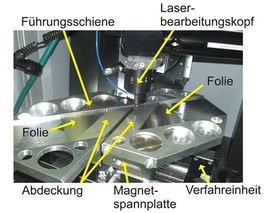 |
Date Announced: 01 Oct 2010
LZH simplifies parameter selection for pulsed laser welding.
Hannover, October 1st, 2010: For small and medium sized enterprises (SME) which use lasers to weld thin metal sheets, lasers with continuous wave radiation are often too expensive. This is due to the high output powers necessary for the welding process. Pulsed Nd:YAG lasers are economically interesting, and offer an alternative to continuous wave lasers.
Due to their high peak pulse output, welding with relatively low medium output power (100 w to 250 W) is possible, and investment costs can be reduced. However, the narrower welding seams from the pulsed lasers not as strong as the seams from continuous lasers. Results can be improved if the parameter selection is optimized. This was the goal of a recently completed project at the Laser Zentrum Hannover e.V. (LZH).
The results of this project aim at simplifying the parameter selection for pulsed laser welding, for example pulse duration, pulse form or pulse peak output. Also, reference parameters for welding with continuous wave radiation have also been recorded. For both types of laser welding, high seams qualities could be qualified and weld imperfections avoided, as shown in surface testing and seam cross-sections. For the investigations, both ferritic and austenitic steels with sheets thicknesses up to 1.5 mm were butt joint welded.
Also, thin foils with a minimal thickness of 50 µm were butt-joint welded. To accomplish this, the LZH developed and constructed a high precision clamping unit, which not only assures a zero gap, but also avoids a lateral edge mismatch.
Especially SMEs can use the results of the welding tests, which are available in an electronic database on the LZH internet site (www.lzh.de). The database provides welding and laser parameters as well as pictures of the expected seams surfaces, cross-sections and micro-hardness tests. Firms can use this data to estimate welding results. Apart from simplifying the selection of appropriate parameters, users can easily expand the database themselves by adding parameters of their own welding tasks to the database and accessing them when needed.
The investigations were commissioned by the Research Association of the German Welding Society (DVS) and funded by the German Federation of Industrial Research Associations "Otto von Guericke" e.V. (AIF) in project 15.297N.
Source: Laser Zentrum Hannover
E-mail: m.botts@lzh.de
Web Site: www.lzh.de
| © 2025 SPIE Europe |
|